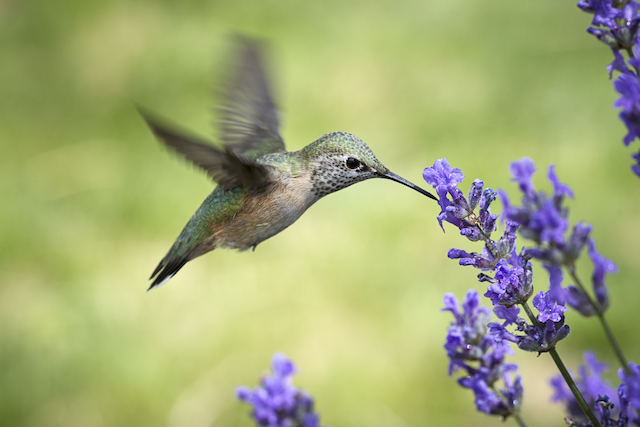


Some hummingbirds can hit notes so high, they go ultrasonic—tones that would challenge even the most gifted sopranos. The behavior has scientists stumped. Based on everything we know about birds, the hummingbirds shouldn’t be able to hear notes as high as they ones they’re singing.
In March and September of this year, two different groups of researchers published observations in Current Biology of five different hummingbird species squeaking out their high-pitched song.
First, Claudio Mello, a neurobiologist with Oregon Health & Science University published his account of Black Jacobin hummingbirds singing really high notes in the Atlantic Forest in Brazil. Then, Fernanda Duque, a PhD candidate at Georgia State University, published her observations after spending two summers tracking down four different species of soprano hummingbirds in the grasslands and cloud forests of Ecuador.
“We didn’t realize at first [the sound] was coming from the hummingbirds,” says Mello. “It sounded more like a cricket or some insect… or even some tree frogs.”
Compared to humans, birds have a fairly limited auditory range. On average, people can hear from about 20 hertz up to 20,000 hertz (20 kHz). A higher frequency means the sound has a shorter wavelength, producing higher notes. Birds can only hear from 100 hertz to 8,000 hertz (8 kHz). Above 20 kHz gets into “ultrasonic” territory, which dogs and cats can hear (up to 40 kHz). As the waves get even smaller, they can allow us to peer inside human bodies (sonogram equipment operates in the 2 to 18 megahertz spectrum).
The Black Jacobins that Mello studied sing almost entirely between 10 kHz and 14 kHz, with harmonic notes all the way up to 80 kHz. In Duque’s study, she found the Ecuadorian Hillstar sings around 13 kHz, the Buff-tailed coronet around 9 kHz, and the Speckled Hummingbird and Violet-tailed Sylph around 11 kHz. Although they aren’t sure exactly how, Mello and Duque think the birds in question can use these songs to communicate with one another.
For one thing, hummingbirds have to learn their calls from one another. And to learn how to make a particular noise, you have to be able to hear it, says Mello. So it stands to reason that the hummingbirds can hear these high-pitched notes and can teach them to other, younger birds.
When the hummingbirds actually make these noises also suggests they can hear them, says Mello. The hummingbirds seem to use them to communicate with one another in territorial disputes, when other birds invade on their feeding territory, or to advertise where they are to members of the opposite sex.
“These birds were often using these calls in close range interactions with each other, more in a territorial setting,” Mello explains.
If the birds can hear one another, it could be that they’ve adopted such high notes could be so they can actually hear each other in their noisy home habitats. For example, three of the species Duque recorded live in the Ecuadorian cloud forest, a habitat filled with croaking frogs, whizzing insects, and calling birds, not to mention rushing rivers and waterfalls and leaves that rustle in the wind.
“What animals do to overcome these obstacles [is] they change the frequency and adapt the frequency of their vocalization so that they do not compete with other animals” or ambient sounds, says Duque.
“It is difficult to imagine that the birds would be vocalizing in these frequencies if they could not hear them, so it seems logical that their hearing systems are modified to allow them to use these frequencies,” Jim McGuire, evolutionary biologist at the University of California Berkeley who has studied hummingbird evolution extensively and was not involved in the new research wrote to Popular Science.
But if the birds can hear these sounds, scientists aren’t sure exactly how they do it.
Part of the problem might not be the hearing abilities of these birds at all, but our ability to study their hearing. It’s harder to study smaller animals than it is large ones, says Christopher Clark, a biologist at UC Riverside who studies hummingbird flight mechanics and non-vocal sounds. The process involves sticking electrodes on the tiny brains of these birds, or spending weeks training them to perform a certain action when they hear a sound.
Blue-throated Hummingbirds can produce sounds up to 30 kHz in the ultrasonic range. But when researchers put electrodes on the brains of these tiny birds to measure their hearing range, they found males and females alike didn’t respond to sounds above 7 kHz.
But another study found Calliope and Rufous Hummingbirds responded to sounds made by wings at frequencies up to 10 kHz. This isn’t as high as some of the documented hummingbird calls, but it pushes the boundary of normal bird hearing.
Hummingbirds are already amazing little things—they can hover in mid air, fly backwards, and survive off sugar water and bugs. We might soon be able to definitively add ultrasonic communication to the list of their incredible abilities.
